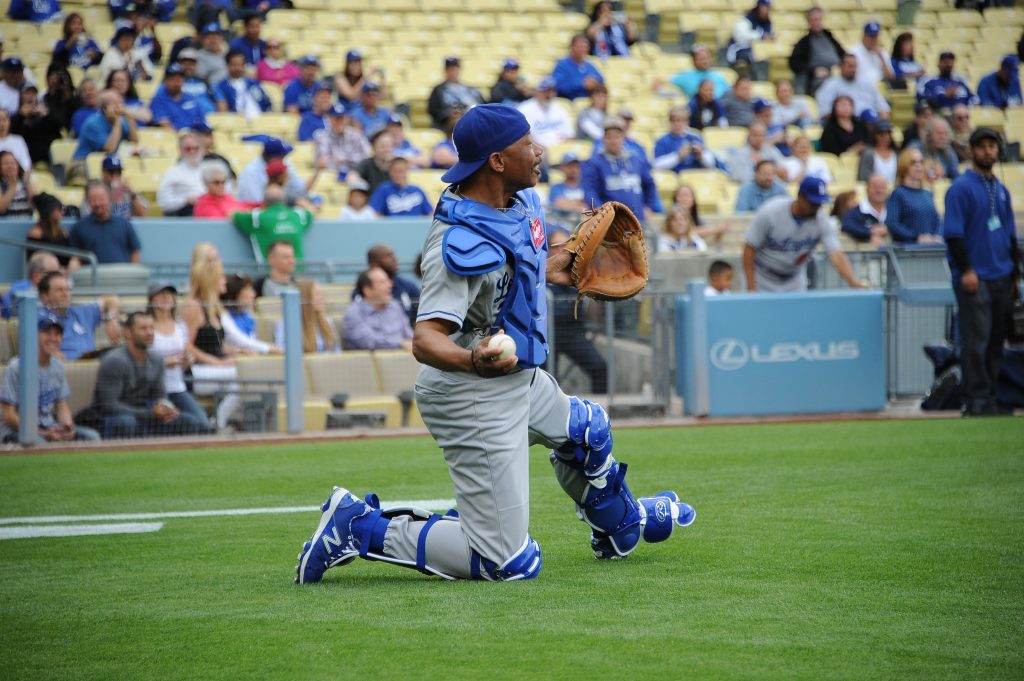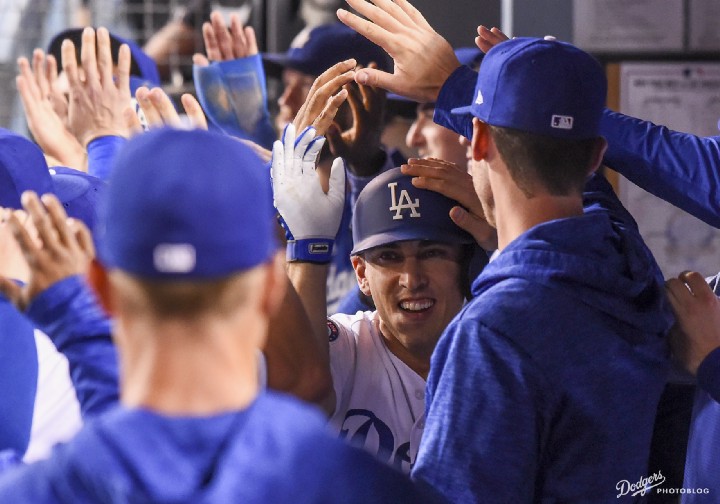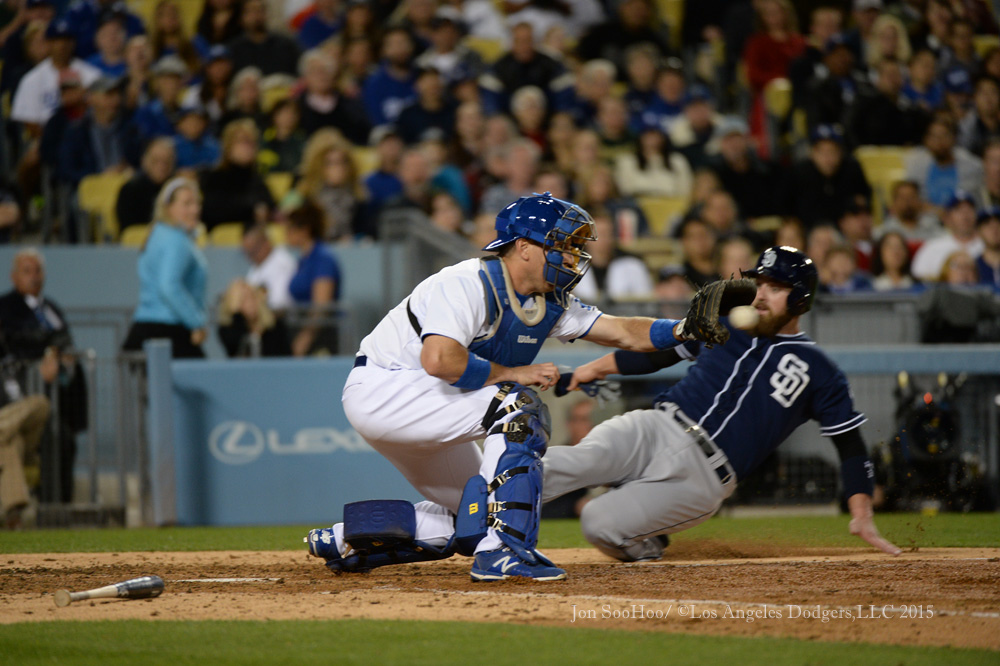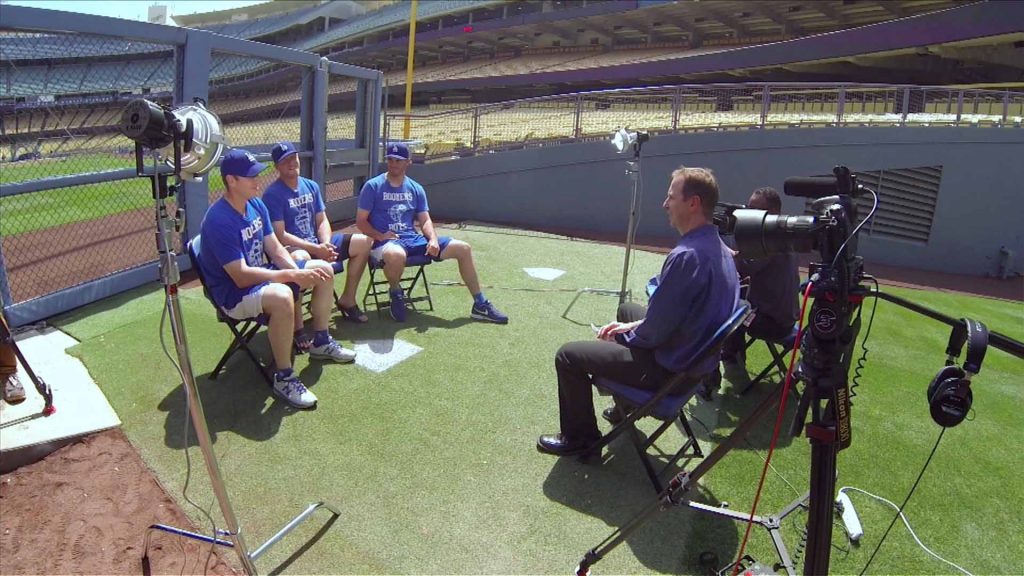
Though he caught in only six games of a 15-season MLB career, Derrel Thomas embraces the opportunity to go behind the plate, such as at the Dodgers’ Old-Timers Game on May 16. (Juan Ocampo/Los Angeles Dodgers)
By Jon Weisman
Though it’s doubtful he’ll ever be called upon for this, especially with Austin Barnes on his way to Los Angeles, Kiké Hernandez has become the Dodgers’ emergency catcher. Just in case, Hernandez caught a bullpen session from Brett Anderson this afternoon.
The last non-catcher the Dodgers have really needed to use behind the plate was Derrel Thomas in 1980. This has always been one of my favorite Dodger stories, not only because it was so unlikely for even a proven utility player like Thomas to go behind the plate, but because it wasn’t a one-time thing.
With Steve Yeager nursing an infected elbow and Triple-A starting catcher Mike Scioscia recovering from a broken finger, Joe Ferguson had to leave in the fourth inning of an April 15, 1980 game at San Diego with a back problem. Thomas went behind the plate for the first time in a game at any level — with knuckleballer Charlie Hough on the mound, no less — and stayed there for the next 31 innings.
“He weighs 150 pounds,” wrote Mike Littwin of the Times that week. “A catcher’s gear weighs almost that much.”
Using Yeager’s glove, Thomas was behind the plate for 137 batters and had four passed balls. No one tried to steal against him on April 15 or April 16, but on April 17, with the slow delivery of Don Sutton 60-and-a-half feet away, Houston stole seven bases, two shy of the Dodger record at the time by a Dodger opponent. However, Thomas did throw out Enos Cabell trying to steal second in the sixth inning, for the only caught stealing of Thomas’ backstop career.
Despite his objective struggles behind the plate, the Dodgers adored Thomas’ effort.
“Show me another guy who could do what he did today,” Dodger manager Tommy Lasorda told Littwin. “I’ve been in baseball nearly all my life, and I’ve never seen anything like it. I’m so grateful to him. He’s a great athlete, but more than that, he’s courageous.”
Said Yeager: “You have to handle pitchers and you have to keep the ball in front of you. I told Derrel a couple of things last night and he remembered. He’s a fast learner, and he’s got a lot of guts. All things considered, he did a great job back there. Hey, I weigh 215 pounds. When’s the last time you saw a 150-pound catcher?”
Here’s more from Littwin:
As Thomas, his uniform caked with dirt, sweat dripping from his brow, limped into the clubhouse, someone asked him how he felt. “I feel, he said, like I should be dead.”
His legs might have been. At that point, he couldn’t have jumped over a chalk baseline.
“I didn’t sleep last night,” he said. “I was too nervous. There are so many things to remember. When they got those guys on base, I just tried to stay relaxed and remember what Yang (Yeager) had told me to do.
“I didn’t care if they stole 30 bases, as long as we won.”
The Dodgers won two of Thomas’ three starts at catcher. Yeager, who had been sidelined since April 13, returned to the starting lineup April 19. Scioscia would then be called up April 20 to make his Major League debut.
After catching the ninth inning of a 2-0, one-hit loss to J.R. Richard of the Astros on April 19 (Yeager had gone out for a pinch-hitter), the Dodgers never needed to use Thomas behind the plate again. But it wasn’t the last time the Dodgers saw him with the tools of ignorance.
In the last season of his 15-year Major League career, as a 34-year-old with Philadelphia, Thomas entered the game behind the plate after Phillies catcher Ozzie Virgil left in the top of the eighth inning of an August 21, 1985 game against visiting Los Angeles with a bruised wrist. In the bottom of that same inning, Thomas hit a three-run homer off Fernando Valenzuela — the 43rd and final home run of Thomas’ big-league career.
It also meant that after previously homering as a first baseman, second baseman, shortstop, third baseman, left fielder, center fielder, right fielder and pinch-hitter, Derrel Thomas had also hit one out as, yes, a catcher.











